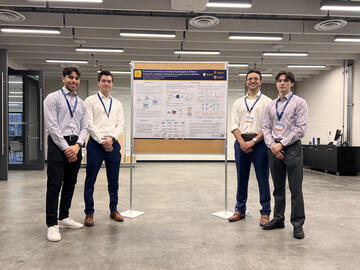May 16, 2024
Winning the National SciNapse Undergraduate Science Case Competition
My team and I had the honour of presenting our scientific research proposal, Exploring the Potential of Antisense Technologies to Enhance Traditional Antifungal Treatments for Candida albicans Biofilms. We won 1st place across Canada in the Upper Division at the National Finals for the SciNapse Undergraduate Science Case Competition (USCC). This was an incredible honour and an extremely rewarding and gratifying experience.
It has been a pleasure working with such a dedicated and collaborative team from multiple different backgrounds, including Ciaran-Byles Ho (Engineering Physics, Queen’s University), Justin Sandrasagra (Mechanical Engineering, Queen’s University), and Tomos Salathiel (Neuroscience, McGill University).
The SciNapse USCC is a national competition founded on the principle that science is much more than memorizing pieces of information and regurgitating them during an exam; rather it is about curiosity, exploration, and risk-taking. Hosted by SciNapse, a national non-profit, with the University of Ottawa, the competition has two rounds. The first is the written round, which takes place in the fall semester. During this round, we were challenged to propose an original research idea, supported by literature, to tackle a real-world issue based on a given topic — this year being Mycology, the study of fungi. Round two was the presentation round, where the top-scoring teams present their novel research proposals to judges at a scientific conference.
During the fall semester, our multidisciplinary cross-institutional team spent weeks in meetings conducting research, discussing, preparing, and refining our project. Combining our past experiences as well as our curiosity, creativity, and hard work, we fully developed a comprehensive research proposal that has the potential to realistically push the boundaries of knowledge and (long-term) medical care.
We explored employing a novel combinatorial therapeutic approach with antisense therapy for treating antifungal C. albicans biofilms, a significant medical problem that lacks strongly effective therapeutics due to antifungal resistance and the unique biofilm structure. Biofilm infections have severe health implications for patients with medical implantables, such as pacemakers and central venous catheters, and with the increased incidence of hospital-acquired C. albicans infections, there is a strong medical need and impact for this proposed research. With our proposed research, we can evaluate a novel therapeutic approach with great potential to overcome current challenges in treating fungal biofilms.
Despite a lack of experience in Mycology, the team immersed itself in the subject, building deep knowledge while crafting our proposal and presentation. I was able to employ my biomedical engineering background, research experience, and passion for translational medical research and communication throughout this competition, especially in combination with my teammates’ unique backgrounds. Our success in proposing a comprehensive and innovative project that is clinically translational showcases the power of multidisciplinary approaches and teamwork in addressing complex medically relevant scientific challenges.
We were thrilled to make the top 10 in the Upper Division, qualifying us for this final round and resulting in the publication of our proposal abstract. We came together in the nation’s capital with the other finalists to present our proposal to the judges, which included professors, a director from Health Canada, and more. In addition to workshops and other opportunities, it was a great experience to present our work and discuss it with the judges. We also learned more about the Ontario ecosystem and transnational research and connected with the other finalists, organizers, judges and guest speakers. And it was exciting for us to ultimately be awarded first place.
What an exceptional opportunity it was to collaborate, ideate, innovate, and learn, as well as represent the University of Calgary on the national stage. I am grateful to the organizers for hosting such a great competition and to the University of Calgary and Scholars Academy for supporting me. I am so very proud of the team for this amazing accomplishment.




